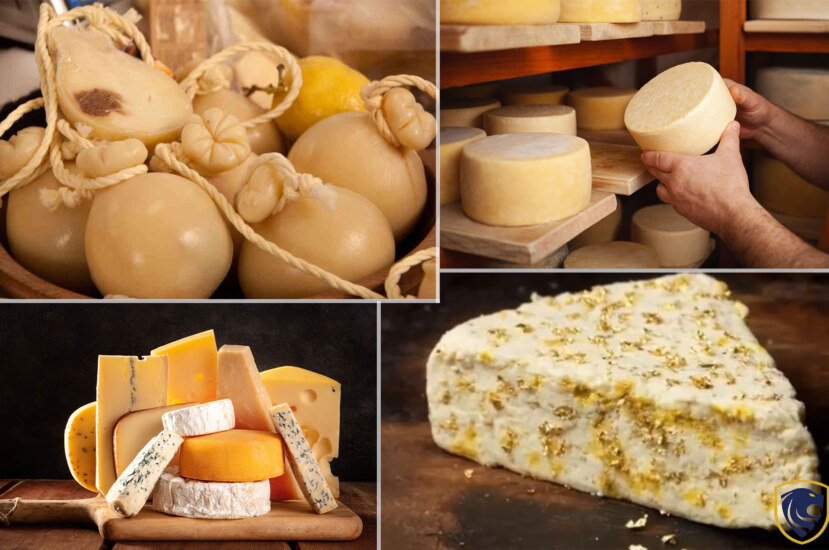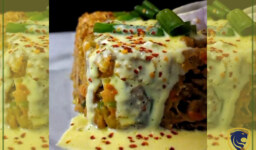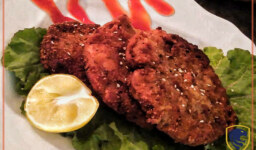Cheese, a beloved culinary delight, comes in a multitude of flavors, textures, and origins. From the milky sweetness of fresh cheese to the pungent aroma of aged varieties, there is a cheese to suit every palate. While many are familiar with popular types like Cheddar and Brie, the world of cheese extends far beyond these well-known varieties. In this article, we will embark on a tantalizing journey to explore some of the most exotic and extraordinary cheese varieties found around the globe. From remote regions to centuries-old traditions, each cheese tells a captivating story and offers a truly unique and unforgettable taste experience. Join us as we delve into the fascinating world of these exceptional cheeses.
Oscypek
Oscypek is a Polish highland cheese that can only be made by less than 150 persons. because they are only once who are qualifies to accomplish that job. These ornamental spindles of golden, smoked cheese are made by traditional shepherds, known as bacas. It is prepared using milk from sheep grazing in the Tatra mountain region.
Nearly 1,000 years ago, a Balkan tribe known as the Vlachs introduced shepherding and cheesemaking to these alpine meadows. So, the way that contemporary bacas function is still traditional. They frequently continue to speak in their own tongue and dress in tiny huts and only use wooden tools. Moreover, fresh cheese is made by the shepherds, who then pour it into intricately carved wooden spindles, barrels, or oval molds. Even oscypek in animal and heart forms is offered by some cheese producers.

Oscypek; Most Exotics Varieties Of Cheese Around The World
Following the selection of a mold, Bacas hangs the cheese on a beam and smokes it with pine or spruce wood. This maintains the interior’s creamy white color while giving the outside a golden tinge. So, the end product is described as briny, smokey, sharp, and having roasted chestnut overtones by tasters.
In the past, the wooden molds used to make oscypek had images relating to the cheese’s use, which included being used as money and a present for the king’s court. These molds are still hand-made by bacas. But the designs no longer show what the cheese is supposed to be used for. Nowadays, Polish restaurants frequently offer thin slices with beer, wine, or vodka. Also, they grill them and serve them with fruit preserves.
Tenili
Tenili cheese, also known as Tenile, is a unique and highly sought-after cheese variety with a rich history and exceptional qualities. Originating from the small village of Tenili in Turkey, this cheese has gained international recognition for its distinct flavor, texture, and traditional production methods.
What makes Tenili cheese so unique is its preparation process. It is a traditional cheese made from raw sheep’s milk, which is known to enhance the complexity of flavors. The cheese undergoes a lengthy aging process, usually ranging from 12 to 24 months. During this time, the cheese develops a strong and intense flavor profile, making it a favorite among cheese connoisseurs.

Tenili; Most Exotics Varieties Of Cheese Around The World
In terms of flavor, Tenili cheese offers a harmonious blend of sharpness and nuttiness. Its taste is robust and savory, with hints of caramel and a pleasant tangy finish. The aging process contributes to the development of a complex range of flavors that deepen with time. This cheese is truly a delight for those who appreciate bold and distinctive tastes.
The texture of Tenili cheese is another remarkable aspect. It has a crumbly and firm texture that gradually melts in the mouth, releasing its flavors. The aging process creates a unique crystalline structure within the cheese, giving it a pleasant crunch and adding to its textural complexity.
Tenili cheese has a rich history rooted in the Turkish culinary tradition. It is believed to have been crafted for centuries by the local shepherds in the Tenili region. The cheese-making process has been passed down through generations, preserving its authenticity and traditional methods.
Horse Cheese
Contrary to its nickname, “Horse Cheese,” this renowned cheese variety does not involve any equine elements. Instead, it derives its name from a clever historical association. The Horse Cheese, also known as Cacuicavallo Podolico, hails from Italy and is produced using milk from the rare and esteemed Italian cow breed called Podolica. Interestingly, during the curing process, the cheese was traditionally suspended from horses for convenient transportation, thus earning its intriguing moniker.
Cacuicavallo Podolico enjoys immense popularity in the southern regions of Italy, particularly in areas like Puglia. The cheese owes its unique characteristics to the Podolica cows, which graze on mountainous terrains during the summer and roam the lush pastures of Puglia during the winter months.

Horse Cheese; Most Exotics Varieties Of Cheese Around The World
This cheese variety is revered for its complexity. It undergoes a meticulous aging process within natural caves. That results in a cheese with a creamy and stringy texture, accompanied by a delightful fruity aroma and earthy flavors. Initially, the cheese appears as a creamy white creation. But as it matures, it develops an enticing amber hue with a flaky texture. Its pear-shaped form adds an element of whimsy to its appeal, as it resembles a fruit rather than a traditional cheese.
Italian cheesemaking’s skill and workmanship are showcased by Cacuicavallo Podolico. The cheese has a devoted following among cheese connoisseurs who value the complexities and subtleties that it offers thanks to its unusual flavour profile and texture. Whether enjoyed on its own or incorporated into a variety of culinary creations, this remarkable cheese continues to captivate palates with its unique attributes, further solidifying its status as a cherished Italian delicacy.
Jersey Blue
Jersey Blue, a remarkable cheese variety, stands out for its exceptional qualities that have garnered worldwide recognition. This exquisite cheese is renowned for its distinct flavor, texture, and origin. Let’s delve into the fascinating world of Jersey Blue and discover what sets it apart from other cheeses.
Originating from the Channel Island of Jersey, this cheese is a testament to the island’s rich dairy heritage. Jersey cows, known for their high-quality milk, are the source of this remarkable cheese. Their milk, which is famously rich in butterfat and protein, contributes to the unique characteristics of Jersey Blue.
The cheese-making process begins with the careful collection of Jersey cow milk, which is then pasteurized to ensure safety and quality. The curdling process is then aided by the addition of particular cultures and rennet to the milk. Curds are chopped and gently stirred to release whey once they have formed. The excess moisture is subsequently squeezed out of the curds by molding and pressing.

Jersey Blue; Most Exotics Varieties Of Cheese Around The World
One of the defining features of Jersey Blue is its distinctive blue mold, which develops during the aging process. This mold, known as Penicillium roqueforti, contributes to the cheese’s flavor and gives it a beautiful marbled appearance. The aging process takes place in carefully controlled environments, allowing the flavors to develop and intensify over time.
The flavor profile of Jersey Blue is a harmonious blend of savory and tangy notes. The cheese offers a delightful balance of creamy, nutty, and slightly sweet undertones, with a hint of earthiness. As the cheese ages, its flavor becomes more robust and complex, offering a rewarding experience for cheese connoisseurs.
Crowdie
The history of crowdie, a raw milk cheese, is based on a variety of sources. Some claim that the fresh dairy spread dates back to the Viking era in Scotland. So, it may have started at the end of the ninth century. But others claim it dates back even further to the Picts, a people group that lived in northern Scotland and whose name first appears in historical records in the late third century. This spreadable, mousse-like substance was formerly common in single-cow homesteads all throughout the nation. But is now hard to come by.

Crowdie; Most Exotics Varieties Of Cheese Around The World
Crowded milk was historically created by crofters (farmers who managed tiny, rented pieces of land) using raw milk. The milk was allowed to sour by the fire or on a windowsill. After slowly curdling the mixture and removing the whey, they added salt and cream. Due to the high moisture content and short shelf life of the resultant cheese, current laws prohibit the production of raw crowdies. Despite the possibility of creating breeding grounds for pathogens in commercial manufacturing settings, devoted craftsmen continue to produce the genuine article covertly. Industrial versions that employ pasteurized milk have nothing in common with classic crowdies.




